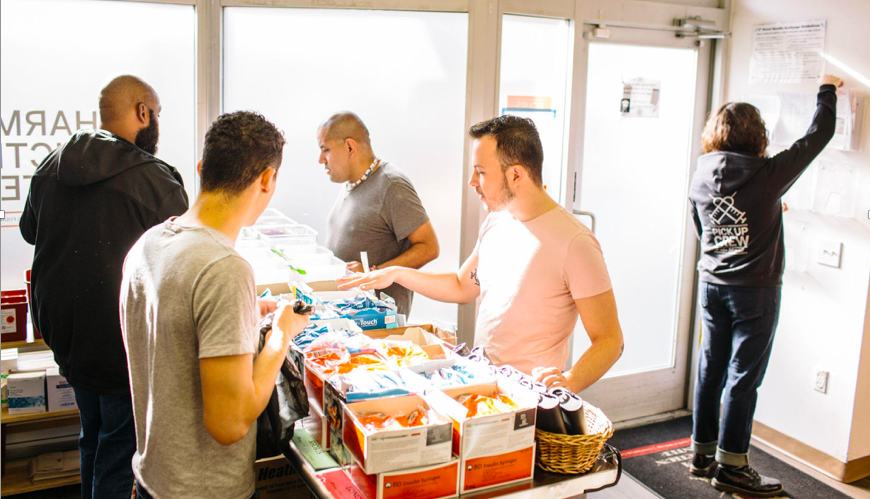When Mayor London Breed Tenderloin announced her Tenderloin State of Emergency, she said a major goal was reducing drug overdoses in the neighborhood. But in hashing out the plan, the Mayor’s Office did not consult “dozens of Tenderloin service providers who work to connect people with services every day,” according to the Coalition on Homelessness.
In fact, the Coalition argues that the most humane and effective approach to reversing overdoses in the Tenderloin is through harm reduction— and it’s been that way for decades.
“In its most basic form, it means we are empowering individuals to make changes in their behavior to reduce negative health outcomes,” said Ro Giuliano, director of Syringe Access Services and PWUD (people who use drugs) Health at the San Francisco AIDS Foundation. “[We’re] providing them with the tools they need to keep themselves alive…Quite simply, harm reduction is compassion.”

Growing out of HIV activist communities in the late 1980s such as ACT-UP, harm reduction has been practiced in San Francisco and around the country for decades. Rather than seeing harm reduction as a specific intervention to be posed against other possibilities, Giuliano sees it as a “continuum that encompasses all of it.” The principles of harm reduction reflect this idea — from understanding drug use as a complex, multi-faceted phenomenon to calling for the non-judgmental, non-coercive provision of services to people who use drugs.
Another main principle that sets harm reduction apart from traditional service approaches is that it “affirms people who use drugs themselves as the primary agents of reducing the harms of their drug use,” according to the National Harm Reduction Coalition. As Giuliano stated, “it’s effective because we’re recognizing that the individual in front of you is the expert on the drug use…it’s their experience that we’re centering.”
The harm reduction approach also understands that drug use does not exist in a vacuum, but rather situates it amidst the “realities of poverty, class, racism, social isolation, past trauma, sex-based discrimination, and other social inequalities,” as stated on the National Harm Reduction Coalition’s website.
In San Francisco, all of these factors have contributed to drug use and drug overdoses, especially among the unhoused community. For service providers using the harm reduction approach, overdoses are seen as a “symptom of something else,” according to Giuliano. “We don’t ignore the devastating impact of racism, trauma, poverty, and the effect of the war on drugs and how that plays out in the community,” she said.
Practically speaking, five organizations make up a collaborative that runs syringe access teams around the city: SFAF, Glide, St. James Infirmary, the Homeless Youth Alliance, and the Drug Users Union. As Giuliano stated, they “provide warm and welcoming spaces for people who use drugs” while “physically meeting someone where they’re at in these low barrier locations.”
For SFAF, the harm reduction site is located on 6th Street between Mission and Mina, while mobile syringe sites rotate between critical neighborhoods around San Francisco each week night: Mondays they’re in the Bayview, Tuesdays on Church & Market, Wednesdays and Fridays on 16th Street and Mission, and Thursdays in Hemlock Alley between Polk and Van Ness.
“There [have been] people who are doing this work for a really long time,” Giuliano siad. “[They] keep showing up, day after day, year after year.” In addition to running its harm reduction site and mobile syringe sites, SFAF also has a pickup crew, a team of 10 people who pick up improperly used syringes, reverse overdoses, and distribute information to the community from 7am-7pm, seven days a week. They are so active that when community members text the team with a picture of an improperly distributed syringe, someone will pick it up within two hours.
In 2021, Giuliano’s team distributed a whopping total of 40,225 doses of Narcan or naloxone, a medicine that “rapidly releases an opioid overdose” according to the National Institute on Drug Abuse. The team has also seen 7,197 overdose reversals reported back to them by community members themselves. “The majority of overdoses being reversed in the city is by community members and people who use drugs,” Giuliano said. This shows that centering solutions on individuals with lived experience of the issue is not only humane and compassionate, but also drives results.
“As folks who do this work…compassion, love, and resilience all goes hand in hand,” Giuliano said. “When you’re working with someone around their use, the important thing is that you’re partnering with them and your expectations and judgments can’t come into play. The goal is having someone feel seen and heard and validated so you can forge that relationship, and then those connections can help reduce the isolation that that person might be experiencing.”
Giuliano also emphasized that “harm reduction work in SF is complex and varied,” and that there aren’t “silver bullet answers.” Rather, SFAF makes up a part of the “tapestry” of services that exist along the harm reduction continuum. Organizations, departments, and teams around the city need to work together and collaborate on providing healthcare to our most vulnerable citizens.
Advocates say the Mayor’s Office should be supporting and investing in existing harm-reduction teams. Rather than circling around the problem, the city should ensure that harm reduction teams “have as much Narcan as they need to distribute to drug users” according to the Coalition of Homelessness, since “many of those working to prevent harm and distributing Narcan to drug users who are on the front lines…rarely have the Narcan supplies they need.”
On top of providing supplies for Narcan, the city can create a safe consumption site and expand Medically Assisted Treatment slots for drug users.
It’s also important to remember that while the spotlight is on the Tenderloin right now, deaths from drug overdoses have been prevalent beyond this neighborhood and moment in time. “People are dying from overdoses in the Mission, in Soma, in Bayview,” Giuliano said. “Funding still needs to be happening on the other side of Market.”



